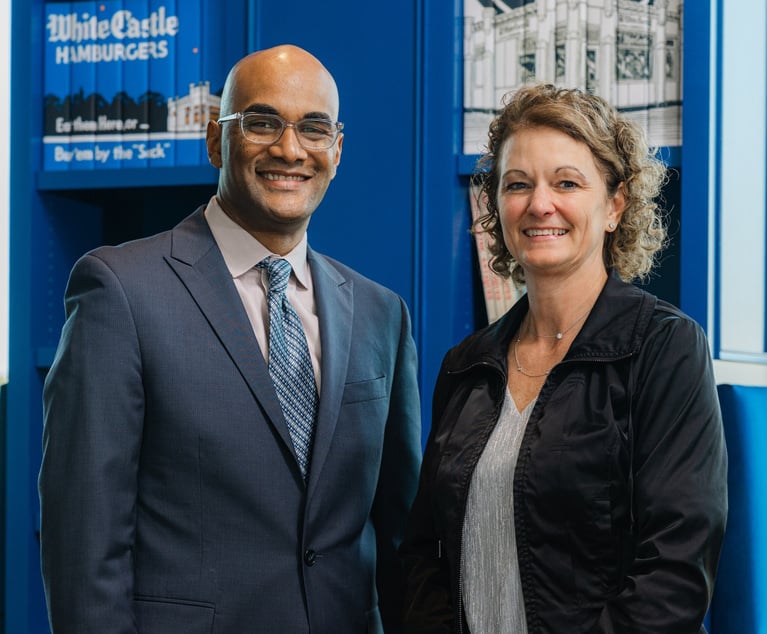Maximizing SuperConference Attendance
With our two favorite days of the year coming up, the InsideCounsel SuperConference on May 23-24, Mike Evers offers his tips for networking the right way.
May 11, 2011 at 08:00 PM
9 minute read
The original version of this story was published on Law.com
We hope to see you in a few days at SuperConference. Even if you can't make it, I hope you will consider the tips in this column when you attend future events. While best practices content and CLE are certainly compelling reasons for coming, I encourage you to maximize the peer-to-peer network building potential of SuperConference. And for anyone in job search mode, let's be candid: Networking is really your primary reason for attending.
Here's the thing. No one wants to become “that guy,” the one who stalks panelists, or who turns Q&A time into a speechmaking opportunity. We don't want you to be “that guy,” either. So, please consider the following suggestions for effective conference networking. Even if you are a veteran of the conference scene and think you already know all there is to know about networking, I encourage you to keep reading. You may find a helpful new suggestion here.
I'll start with the obvious. Panel speakers are the most sought after networking targets. That makes sense. General counsel and managerial level AGCs form the bulk of our conference faculty. They are decision-making buyers for law firms, and job seekers will do almost anything for an introduction. However, a mere introduction is not synonymous with networking.
Susan Sneider offers several definitions of networking from successful attorneys in her fabulous book, “A Lawyer's Guide to Networking.” My favorite comes from John Mitchell: “Networking is building relationships through helping people. You can't help someone if you don't know what that person needs. You must ask others about themselves to learn what they need.”
Mitchell's definition explains why networking at a conference is so difficult and sometimes frustrating. Often, the most you can accomplish at a conference is a positive connection that may warm your target to quality post-conference follow-up. By the way, successful networkers will bristle at my use of the word “target.” Sophisticated long-term relationship building has a real pay-it-forward quality, the essence of which is caring about and helping as many people in your life path as possible, not just those who may be able to give you a job interview or a piece of business tomorrow. I strongly agree, but in the context of a conference, I stand by my somewhat mercenary term. Rather than leave introductions to chance, I do advise that you attend with a strategy in mind that includes selectively targeting participants.
Therefore, preparation is essential to maximizing conference value. Research the speakers beforehand. A faculty list is always available at a conference's website. If you know a speaker personally, call her now and tell her how much you look forward to seeing her at the conference. Once you are together at the conference, she may be able to introduce you to other panelists. Similarly, if you know someone who knows one of the panelists, act on that. Is your contact willing to facilitate a pre-conference online introduction that you can follow-up in person? Short of that, ask your contact if you may drop her name to strengthen an otherwise “cold” introduction at the conference.
When deciding which breakout session to attend as three are running simultaneously, resist the natural inclination to follow the topic of most interest to you. Choose your session based on who is speaking. It's nice when your topic preference coincides with speaker choice, but if your primary goal is to meet someone, start by hearing what he or she has to say– whether it's of genuine interest to you or not. And listen first! Don't make the rude mistake of walking up to a panelist just before a session. Even veteran speakers are in pregame mode and might even be a little nervous. Leave them alone.
During the interactive or Q&A portions of the session, here is your “don't” and “do” to remember: Don't make a speech to show everyone in the room that you are smart and know something interesting about the topic. First, everyone in the room is smart, and secondly your point is probably not nearly as interesting or enlightening as you think. Do ask an engaging question. The panelists have thought a great deal about the topic at hand, they care about it and they take it seriously. Otherwise, they would not have made the panel speaking commitment. A short but engaging question will catch the panel's attention, and give them an opportunity to go off script a bit. A good speaker who likes your question will probably look you in the eye at first during her reply. You have now laid the groundwork for the post-session introduction.
While some speakers rush off after a session, most are courteous and stick around for a bit. Even frequent panelists enjoy a little adrenaline rush from public speaking, and afterwards they may be in a pretty good mood. The challenge is that you will be one of several audience members lining up for the handshake and introduction. Don't be the eager beaver who rushes up first. Wait for the speaker to get through with the people who have no clue how to network. Be the patient person with the last voice, a calm and casual voice. Introduce yourself, and simply thank the speaker for addressing your question. She will remember your question and may engage you in some discussion. But don't force conversation. And don't start talking about yourself. Confidently suggest that you would welcome the opportunity for further discussion at another time. Don't provide a business card (unless it's requested). You will figure out easily enough how to reach the target for follow-up after she leaves the conference. Hopefully, however, your networking target will remain at the conference and you can approach her for a higher quality conversation later in the day.
The best conversations happen in the general open areas and in the exhibit hall during breaks, lunches and receptions. Here is where preparation is essential. If you have researched someone online, or heard him speak, and if you are paying attention, you should be able to recognize your target from a reasonable distance. Don't be the dork who is walking around uncomfortably trying to read name tags. By knowing your target, you can approach someone with confidence.
Then, what do you say? We all harbor a fear of rejection, and breaking the ice may not be easy. When you hear anyone say, “I hate networking,” they are almost always thinking about this very moment. Warning: The advice I'm about to offer goes against the grain of most networking books. Conventional wisdom suggests a casual, non-threatening dialogue start, such as this, “What did you think of the keynote speech?” My advice is to be forthright, along these lines, “Hello, Ms. Big, my name is Mike Evers and I've been looking forward to meeting you.” Only a horse's bottom would respond with anything other than something like, “Really, why is that?” or “OK, nice to meet you.” So, everything will ride on what you say next.
If you are winging this conversation, you will simply embarrass yourself. Before the conference, identify challenges facing Ms. Big's company, identify any commonality in your backgrounds and identify something you admire about Ms. Big's company or, better yet, something Ms. Big has accomplished in her career. Then you will be prepared for a short or long (“long” being five minutes) conversation with Ms. Big. Focus everything on her. “I admire how you came in after a backdating scandal and turned Acme Co. into a model for implementing compliance processes,” for example. Have two or three such “intro salvos,” as I call them, in mind. Then, let the conversation take its natural course and listen carefully to anything Ms. Big says. Whether she is truly engaged in this conversation or just being polite, she will ask the polite question, “Where are you from?” or “Tell me about you.”
Your reply should not start with “I am from…” or “I am an expert in…” A good reply starts with, “I help companies like yours…” Next, if you are unemployed: “I helped XYZ company with their (insert expertise here) issues for six years in an AGC role.” If you're from a law firm, use something like: “I've used the multi-office resources at (insert firm name here) to build teams that truly create efficiencies for my clients. I really do know how to use the BigLaw platform to help my clients consolidate work and save money.” Hopefully these examples give you a sense of the focus you should have. The specifics will vary endlessly.
Don't overstay your welcome. Lingering sends the message that you will be needy, not helpful.
Of course, you will have ample opportunity to meet fellow attendees of the conference, individuals whom you have not researched. You can really do as much of this as you choose to do. My advice for how to go about this is more in tune with classic networking best practices. Make people comfortable, bring them into conversations, start with small talk and seek out commonality while doing so. It's also OK to have a sense of humor about this. I dare you to try this: “Hello, I'm Jennifer. I just read a column about networking at this conference, and the author suggests starting with small talk. I can start with weather, sports, local restaurants or movies. Which do you prefer?” If you are self-confident, humble and real, people will enjoy this kind of approach.
More conventional wisdom that I agree with: Don't intrude on a pair of two if they appear to be engaged in a rather focused one-on-one conversation. Do break into any other size group or approach any single person who is not working on a communications device.
Over the years, I've gotten pretty good at starting conversations. Hey, we all need to be good at something. However, I am still trying to break a very bad habit. Because I follow my own advice and come to conferences with a mission to meet certain people in mind, I find myself looking beyond the group I'm in at the moment, in search of my strategic targets. It's terribly rude and I fight myself constantly to stop doing it. The person you are speaking with right now deserves your full attention. If you listen, truly engage, and care, then the other person will develop a positive first impression of you. Only good possibilities can come from that.
Please say hello at our SuperConference. Mention this column and then we'll see how many introductions we can make for each other. Let the networking begin!
This content has been archived. It is available through our partners, LexisNexis® and Bloomberg Law.
To view this content, please continue to their sites.
Not a Lexis Subscriber?
Subscribe Now
Not a Bloomberg Law Subscriber?
Subscribe Now
NOT FOR REPRINT
© 2025 ALM Global, LLC, All Rights Reserved. Request academic re-use from www.copyright.com. All other uses, submit a request to [email protected]. For more information visit Asset & Logo Licensing.
You Might Like
View All
White Castle GC Becomes Chain's First President From Outside Family

Beyond the Title: Developing a Personal Brand as General Counsel
Trending Stories
- 1Courts, Lawyers Press On With Business as SoCal Wildfires Rage
- 2Florida, a Political Epicenter, Is the Site of Brownstein Hyatt's 13th Office
- 3Law Firms Close Southern California Offices Amid Devastating Wildfires
- 4Lawsuit alleges racial and gender discrimination led to an Air Force contractor's death at California airfield
- 5Holland & Knight Picks Up 8 Private Wealth Lawyers in Los Angeles
Who Got The Work
Michael G. Bongiorno, Andrew Scott Dulberg and Elizabeth E. Driscoll from Wilmer Cutler Pickering Hale and Dorr have stepped in to represent Symbotic Inc., an A.I.-enabled technology platform that focuses on increasing supply chain efficiency, and other defendants in a pending shareholder derivative lawsuit. The case, filed Oct. 2 in Massachusetts District Court by the Brown Law Firm on behalf of Stephen Austen, accuses certain officers and directors of misleading investors in regard to Symbotic's potential for margin growth by failing to disclose that the company was not equipped to timely deploy its systems or manage expenses through project delays. The case, assigned to U.S. District Judge Nathaniel M. Gorton, is 1:24-cv-12522, Austen v. Cohen et al.
Who Got The Work
Edmund Polubinski and Marie Killmond of Davis Polk & Wardwell have entered appearances for data platform software development company MongoDB and other defendants in a pending shareholder derivative lawsuit. The action, filed Oct. 7 in New York Southern District Court by the Brown Law Firm, accuses the company's directors and/or officers of falsely expressing confidence in the company’s restructuring of its sales incentive plan and downplaying the severity of decreases in its upfront commitments. The case is 1:24-cv-07594, Roy v. Ittycheria et al.
Who Got The Work
Amy O. Bruchs and Kurt F. Ellison of Michael Best & Friedrich have entered appearances for Epic Systems Corp. in a pending employment discrimination lawsuit. The suit was filed Sept. 7 in Wisconsin Western District Court by Levine Eisberner LLC and Siri & Glimstad on behalf of a project manager who claims that he was wrongfully terminated after applying for a religious exemption to the defendant's COVID-19 vaccine mandate. The case, assigned to U.S. Magistrate Judge Anita Marie Boor, is 3:24-cv-00630, Secker, Nathan v. Epic Systems Corporation.
Who Got The Work
David X. Sullivan, Thomas J. Finn and Gregory A. Hall from McCarter & English have entered appearances for Sunrun Installation Services in a pending civil rights lawsuit. The complaint was filed Sept. 4 in Connecticut District Court by attorney Robert M. Berke on behalf of former employee George Edward Steins, who was arrested and charged with employing an unregistered home improvement salesperson. The complaint alleges that had Sunrun informed the Connecticut Department of Consumer Protection that the plaintiff's employment had ended in 2017 and that he no longer held Sunrun's home improvement contractor license, he would not have been hit with charges, which were dismissed in May 2024. The case, assigned to U.S. District Judge Jeffrey A. Meyer, is 3:24-cv-01423, Steins v. Sunrun, Inc. et al.
Who Got The Work
Greenberg Traurig shareholder Joshua L. Raskin has entered an appearance for boohoo.com UK Ltd. in a pending patent infringement lawsuit. The suit, filed Sept. 3 in Texas Eastern District Court by Rozier Hardt McDonough on behalf of Alto Dynamics, asserts five patents related to an online shopping platform. The case, assigned to U.S. District Judge Rodney Gilstrap, is 2:24-cv-00719, Alto Dynamics, LLC v. boohoo.com UK Limited.
Featured Firms
Law Offices of Gary Martin Hays & Associates, P.C.
(470) 294-1674
Law Offices of Mark E. Salomone
(857) 444-6468
Smith & Hassler
(713) 739-1250








